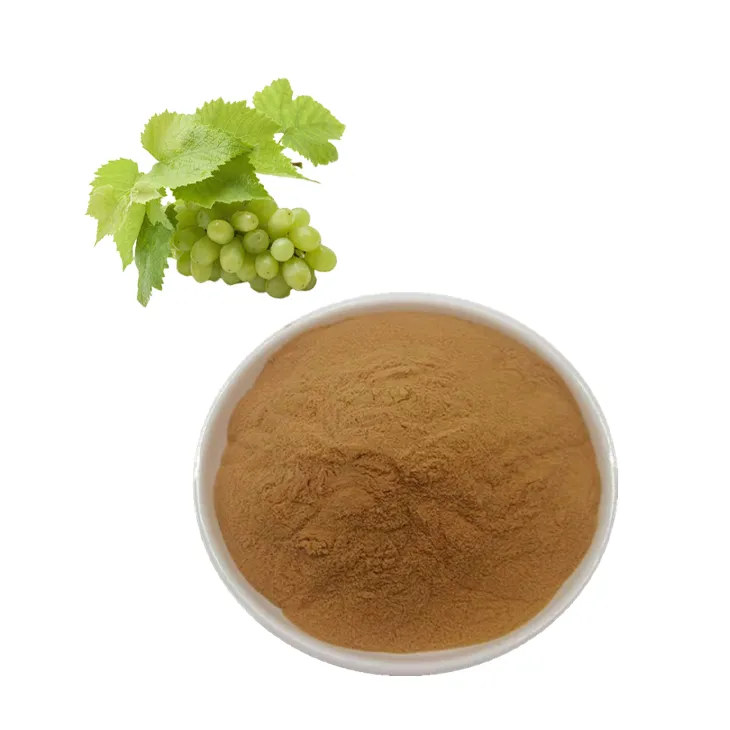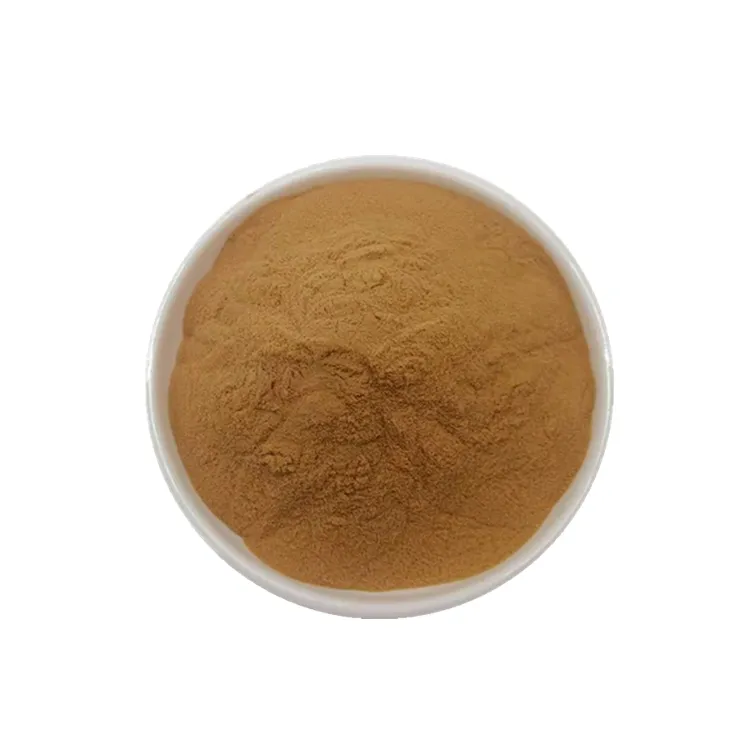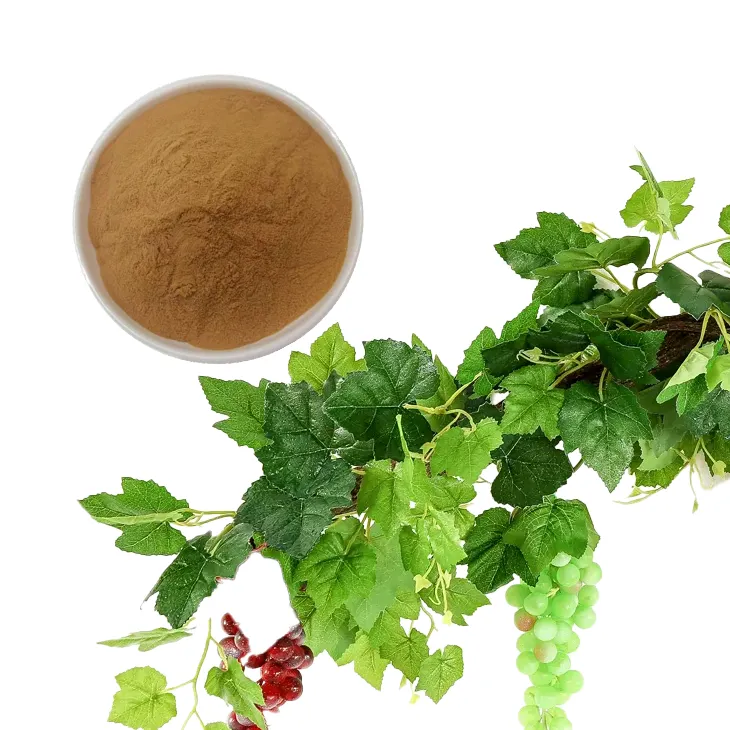- 0086-571-85302990
- sales@greenskybio.com
Grape Leaf Extract: From Leaves to Extraction.
2024-11-13

1. Introduction
Grape Leaf Extract has been gaining increasing attention in recent years due to its potential health benefits and diverse applications. The journey from the grape leaves growing on the vine to the final extract is a complex and multi - faceted process. This article will delve into the various aspects of this transformation, starting from the composition of grape leaves, through the extraction techniques, the influence of environmental factors, and finally, the market potential of the extract.

2. Composition of Grape Leaves
Grape leaves are rich in a variety of bioactive compounds, which are the basis for their extraction and subsequent applications.
2.1 Polyphenols
Polyphenols are one of the most important groups of compounds found in grape leaves. These include flavonoids such as Quercetin, kaempferol, and rutin. Flavonoids are known for their antioxidant properties, which can help to protect cells from damage caused by free radicals. They also have anti - inflammatory effects and may play a role in preventing chronic diseases such as heart disease, cancer, and neurodegenerative disorders.
2.2 Tannins
Another significant component of grape leaves is tannins. Tannins contribute to the astringency of the leaves and have antimicrobial properties. They can also interact with proteins, which may have implications for their use in food and pharmaceutical applications. In addition, tannins are believed to have antioxidant and anti - inflammatory effects similar to those of polyphenols.
2.3 Minerals and Vitamins
Grape leaves also contain various minerals such as potassium, calcium, and magnesium, as well as vitamins like vitamin C and vitamin K. These nutrients are essential for maintaining normal physiological functions in the body. For example, potassium is important for heart function and fluid balance, while vitamin C is a powerful antioxidant and vitamin K is involved in blood clotting.

3. Extraction Techniques
The extraction of bioactive compounds from grape leaves is a crucial step in obtaining a high - quality extract. There are both traditional and modern extraction methods, each with its own advantages and disadvantages.
3.1 Traditional Extraction Methods
- Infusion and Decoction:
Infusion is a simple method where grape leaves are soaked in hot water for a period of time. Decoction, on the other hand, involves boiling the leaves in water. These methods are easy to perform and do not require complex equipment. However, they may not be very efficient in extracting all the bioactive compounds, especially those that are less soluble in water.
- Maceration:
Maceration involves soaking the grape leaves in a solvent, such as ethanol or methanol, for an extended period. This method can extract a wider range of compounds compared to infusion and decoction. However, it is time - consuming and may require a large amount of solvent.
3.2 Modern Extraction Methods
- Supercritical Fluid Extraction (SFE):
Supercritical fluid extraction uses a supercritical fluid, usually carbon dioxide (CO₂), as the solvent. At supercritical conditions, CO₂ has properties similar to both a gas and a liquid, which allows it to penetrate the plant material effectively and extract the bioactive compounds. SFE is a clean and efficient method, as CO₂ is non - toxic, non - flammable, and can be easily removed from the extract. However, it requires specialized and expensive equipment.
- Ultrasonic - Assisted Extraction (UAE):
Ultrasonic - assisted extraction utilizes ultrasonic waves to disrupt the cell walls of the grape leaves, facilitating the release of bioactive compounds into the solvent. This method can significantly reduce the extraction time and improve the extraction efficiency. It is also relatively simple and cost - effective compared to SFE.
- Microwave - Assisted Extraction (MAE):
Microwave - assisted extraction uses microwaves to heat the solvent and the grape leaves simultaneously. This causes rapid heating and expansion within the plant cells, leading to the release of bioactive compounds. MAE is a fast and efficient method, but it may require careful control of the microwave power and extraction time to avoid degradation of the compounds.
3.3 Comparison of Extraction Methods
When comparing the traditional and modern extraction methods, several factors need to be considered. Modern methods such as SFE, UAE, and MAE generally offer higher extraction efficiency and shorter extraction times compared to traditional methods. However, they also require more advanced equipment and technical expertise. Traditional methods, on the other hand, are more accessible and may be suitable for small - scale or home - based extractions. The choice of extraction method also depends on the specific bioactive compounds of interest, as different methods may be more effective for different types of compounds.

4. Influence of Environmental Factors on Extract Quality
The environmental conditions during the growth of grape leaves can have a significant impact on the quality of the extract obtained from them.
4.1 Climate
- Temperature: Extreme temperatures, whether too hot or too cold, can affect the biosynthesis of bioactive compounds in grape leaves. For example, high temperatures may lead to the degradation of certain polyphenols, while low temperatures can slow down the growth and development of the leaves, resulting in lower levels of compound accumulation.
- Rainfall: Adequate rainfall is essential for the growth of grape vines and the development of healthy leaves. Insufficient rainfall can cause water stress in the plants, which may affect the synthesis and accumulation of bioactive compounds. On the other hand, excessive rainfall can lead to fungal and bacterial infections, which can also impact the quality of the leaves and the extract.
- Sunlight: Grape leaves require an appropriate amount of sunlight for photosynthesis. Insufficient sunlight can lead to reduced production of bioactive compounds, while excessive sunlight can cause photo - oxidative stress, which may damage the leaves and affect the quality of the extract.
4.2 Soil Conditions
- Soil type: Different soil types, such as sandy, loamy, or clayey soils, can affect the nutrient availability and uptake by grape vines. For example, well - drained loamy soils are generally considered ideal for grape cultivation as they provide a good balance of water, air, and nutrients. The nutrient content of the soil, including nitrogen, phosphorus, and potassium, can directly influence the biosynthesis of bioactive compounds in the leaves.
- Soil pH: The pH of the soil can also have an impact on the growth of grape vines and the quality of the leaves. Most grape varieties prefer slightly acidic to neutral soil pH (around 5.5 - 7.0). If the soil pH is too acidic or too alkaline, it can affect the availability of certain nutrients and the activity of soil microorganisms, which in turn can influence the production of bioactive compounds in the leaves.
5. Market Potential of Grape Leaf Extract
The market potential for Grape Leaf Extract is significant, driven by consumer demand for natural products and the increasing recognition of the health benefits associated with bioactive compounds found in grape leaves.
5.1 Consumer Demand for Natural Products
In recent years, there has been a growing trend among consumers towards natural and plant - based products. Grape leaf extract, being a natural product rich in bioactive compounds, is seen as an attractive option for those seeking alternative health solutions. Consumers are increasingly interested in products that can support their overall health and well - being, such as those with antioxidant, anti - inflammatory, and anti - aging properties.
5.2 Applications in Different Industries
- Food and Beverage Industry: Grape leaf extract can be used as a natural preservative due to its antimicrobial properties. It can also be added to food and beverages as a functional ingredient to enhance their nutritional value and antioxidant content. For example, it could be added to juices, wines, or processed foods.
- Pharmaceutical Industry: The bioactive compounds in grape leaf extract, such as polyphenols and tannins, have potential pharmaceutical applications. They may be used in the development of drugs for the treatment of various diseases, including cardiovascular diseases, cancer, and diabetes. Additionally, grape leaf extract may be used in the form of dietary supplements to promote health and prevent diseases.
- Cosmetic Industry: The antioxidant and anti - inflammatory properties of grape leaf extract make it suitable for use in cosmetic products. It can be added to creams, lotions, and serums to protect the skin from oxidative stress, reduce inflammation, and improve skin health. It may also have anti - aging effects, such as reducing wrinkles and improving skin elasticity.
5.3 Market Challenges and Opportunities
Despite the promising market potential, there are also some challenges associated with the commercialization of grape leaf extract. One of the main challenges is the lack of standardized extraction methods and quality control measures. This can lead to variability in the quality and composition of the extract, which may affect its efficacy and safety. Another challenge is the limited research on the long - term effects and potential side effects of grape leaf extract in humans. However, these challenges also present opportunities for further research and development, as well as the establishment of industry standards to ensure the quality and safety of grape leaf extract products.
6. Conclusion
The process of transforming grape leaves into grape leaf extract is a complex one that involves understanding the composition of the leaves, selecting appropriate extraction techniques, considering the influence of environmental factors, and recognizing the market potential. With the increasing demand for natural products and the growing awareness of the health benefits of bioactive compounds, grape leaf extract has the potential to become an important ingredient in various industries. However, further research is needed to overcome the current challenges and fully realize its potential.
FAQ:
What are the main bioactive compounds in grape leaves?
Grape leaves are rich in various bioactive compounds. Some of the main ones include flavonoids, phenolic acids, and tannins. Flavonoids, for example, are known for their antioxidant properties. Phenolic acids also contribute to the antioxidant activity and may have anti - inflammatory effects. Tannins can affect the taste and have potential health - promoting properties as well.
What are the traditional extraction techniques for grape leaf extract?
Traditional extraction techniques for grape leaf extract often include methods like maceration. In maceration, the grape leaves are soaked in a solvent (such as ethanol or water) for a certain period. This allows the bioactive compounds to be transferred from the leaves to the solvent. Another traditional method could be decoction, where the leaves are boiled in water to extract the desired components.
How do modern extraction techniques compare to traditional ones for grape leaf extract?
Modern extraction techniques for grape leaf extract offer several advantages over traditional ones. Modern methods such as supercritical fluid extraction (SFE) are more efficient in extracting specific bioactive compounds. SFE can operate at lower temperatures compared to traditional methods like decoction, which helps to preserve the integrity of heat - sensitive compounds. Additionally, modern techniques often provide better control over the extraction process, resulting in a more consistent quality of the extract.
How do environmental factors during grape leaf growth affect the quality of the extract?
Environmental factors during grape leaf growth play a crucial role in the quality of the extract. For example, sunlight exposure affects the synthesis of bioactive compounds. Adequate sunlight can increase the production of flavonoids. Temperature also matters. Extreme temperatures, either too hot or too cold, can disrupt the normal physiological processes in the leaves and potentially reduce the amount or quality of bioactive compounds. Soil quality, including nutrient content and pH, can influence the uptake of minerals by the leaves, which in turn can impact the composition of the extract.
What is the market potential of grape leaf extract?
The market potential of grape leaf extract is significant. With the increasing consumer demand for natural products, grape leaf extract is attracting attention in various industries. In the food and beverage industry, it can be used as a natural antioxidant or flavor enhancer. In the pharmaceutical and nutraceutical industries, its bioactive compounds may have potential health - promoting properties, which could lead to the development of new drugs or dietary supplements. The cosmetic industry may also use it in products for its antioxidant and skin - beneficial properties.
Related literature
- Bioactive Compounds in Grape Leaves: Composition and Potential Health Benefits"
- "Extraction Techniques for Grape Leaf - Derived Bioactive Compounds: A Review"
- "The Influence of Environmental Factors on Grape Leaf Quality and Extract Composition"
- "Market Trends and Opportunities for Grape Leaf Extract in the Natural Product Industry"
- ▶ Hesperidin
- ▶ Citrus Bioflavonoids
- ▶ Plant Extract
- ▶ lycopene
- ▶ Diosmin
- ▶ Grape seed extract
- ▶ Sea buckthorn Juice Powder
- ▶ Fruit Juice Powder
- ▶ Hops Extract
- ▶ Artichoke Extract
- ▶ Mushroom extract
- ▶ Astaxanthin
- ▶ Green Tea Extract
- ▶ Curcumin
- ▶ Horse Chestnut Extract
- ▶ Other Product
- ▶ Boswellia Serrata Extract
- ▶ Resveratrol
- ▶ Marigold Extract
- ▶ Grape Leaf Extract
- ▶ New Product
- ▶ Aminolevulinic acid
- ▶ Cranberry Extract
- ▶ Red Yeast Rice
- ▶ Red Wine Extract
-
Peppermint Extract Powder
2024-11-13
-
Honeysuckle Pollen
2024-11-13
-
Beetroot juice Powder
2024-11-13
-
Genistein
2024-11-13
-
Red Date Extract
2024-11-13
-
Chaste Berry Extract
2024-11-13
-
Purple Sweet Potato Extract
2024-11-13
-
Bamboo Leaf extract
2024-11-13
-
Green coffee bean Extract
2024-11-13
-
Europen Bilberry Extract
2024-11-13





















